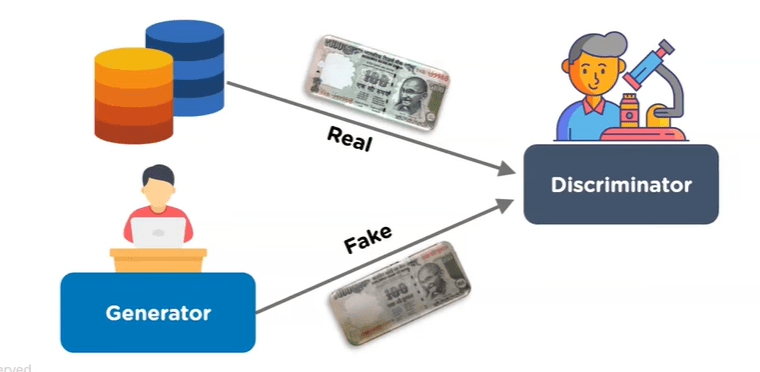Day 7 – What Are GANs? | Generative Adversarial Networks in Deep Learning
 Naveen
Naveen- 0
In this article, we will explore an important and popular deep learning neural network called Generative Adversarial Networks (GANs). GANs were introduced in 2014 by Ian J. Goodfellow and co-authors and have since become very popular in the field of machine learning. GANs are an unsupervised learning task that consists of two models, the generator and the discriminator, which compete with each other to analyze, capture, and copy the variations within a dataset. GANs can be used to generate new examples that could have been drawn from the original dataset.
What are Generative Adversarial Networks?
Generative Adversarial Networks (GANs) are a type of deep learning neural network that consists of two models, the generator and the discriminator. The generator is responsible for creating fake data to be trained on the discriminator. It learns to generate plausible data by taking a fixed-length random vector carrying noise as input and generating a sample. The main aim of the generator is to make the discriminator classify its output as real. The discriminator, on the other hand, is a neural network model that identifies real data from the fake data generated by the generator. The discriminator’s training data comes from two sources: real data instances and fake data instances created by the generator.

The Working of GANs
GANs work by training the generator and discriminator simultaneously in an adversarial game. The generator tries to fool the discriminator by generating data similar to those in the training set, while the discriminator tries not to be fooled by identifying fake data from real data. Both networks work together to learn and train complex data such as audio, video, or image files.
The Generator
The generator in GANs is a neural network that creates fake data to be trained on the discriminator. It learns to generate plausible data by taking a fixed-length random vector carrying noise as input and generating a sample. The generator’s main aim is to make the discriminator classify its output as real. The generator includes a noisy input vector, the generator network, the discriminator network, and a generator loss. The backpropagation method is used to adjust each weight in the right direction by calculating the weight’s impact on the output.

The Discriminator
The discriminator in GANs is a neural network model that identifies real data from the fake data generated by the generator. The discriminators’ training data comes from two sources: real data instances and fake data instances created by the generator. The discriminator classifies both real data and fake data from the generator. The discriminator loss penalizes the discriminator for misclassifying a real data instance as fake or a fake data instance as real.

Mathematical formula
The mathematical formula for working on GANs can be represented as:

Where,
G = Generator
D = Discriminator
Pdata(x) = distribution of real data
p(z) = distribution of generator
x = sample from Pdata(x)
z = sample from P(z)
D(x) = Discriminator network
G(Z) = Generator network
Training GANs
Training a GAN involves a series of steps:
- Define the problem and collect data.
- Choose the GAN architecture suitable for your specific problem.
- Train the Discriminator on real data.
- Generate fake data using the Generator.
- Train the Discriminator on the generated data.
- Train the Generator to deceive the Discriminator.
Types of GANs
There are several types of GANs, including:
- Vanilla GANs: Vanilla GANs have a min-max optimization formula where the discriminator is a binary classifier using sigmoid cross-entropy loss during optimization. The generator and discriminator are simple multi-layer perceptrons.
- Deep Convolutional GANs (DCGANs): DCGANs support convolutional neural networks instead of vanilla neural networks at both the discriminator and generator. They are more stable and generate higher quality images. The generator uses convolutional layers with fractional strided convolutions, while the discriminator uses convolutional layers with strided convolutions.
- Conditional GANs (cGANs): cGANs extend vanilla GANs by using an extra label information to generate better results. An additional parameter called “y” is added to the generator to generate the corresponding data, and labels are fed as input to the discriminator to help distinguish real data from fake data generated.
- Super Resolution GANs (SRGANs): SRGANs use deep neural networks along with adversarial neural networks to produce higher resolution images. They generate photorealistic high-resolution images when given low-resolution images.
Applications of GANs
GANs have various applications, including:
1 – Training images of cartoon characters: GANs can be used to generate faces of anime characters and Pokemon characters.

2 – Generating realistic human faces: GANs are used to generate realistic faces that do not exist in reality.

3 – Text-to-image translation: GANs can build realistic images from textual descriptions of objects like birds, humans, and other animals.

4 – Creating 3D objects: GANs can generate 3D models using 2D pictures of objects from multiple perspectives. They are popular in the gaming industry for automating the task of creating realistic 3D characters and backgrounds.

Conclusion
Generative Adversarial Networks (GANs) are a powerful tool in the field of machine learning that consist of a generator and discriminator working together to generate new examples that could have been drawn from the original dataset. GANs have various applications and are widely used in generating images, text-to-image translation, and creating 3D objects.
If you found this article helpful and insightful, I would greatly appreciate your support. You can show your appreciation by clicking on the button below. Thank you for taking the time to read this article.
Popular Posts
- From Zero to Hero: The Ultimate PyTorch Tutorial for Machine Learning Enthusiasts
- Day 3: Deep Learning vs. Machine Learning: Key Differences Explained
- Retrieving Dictionary Keys and Values in Python
- Day 2: 14 Types of Neural Networks and their Applications
